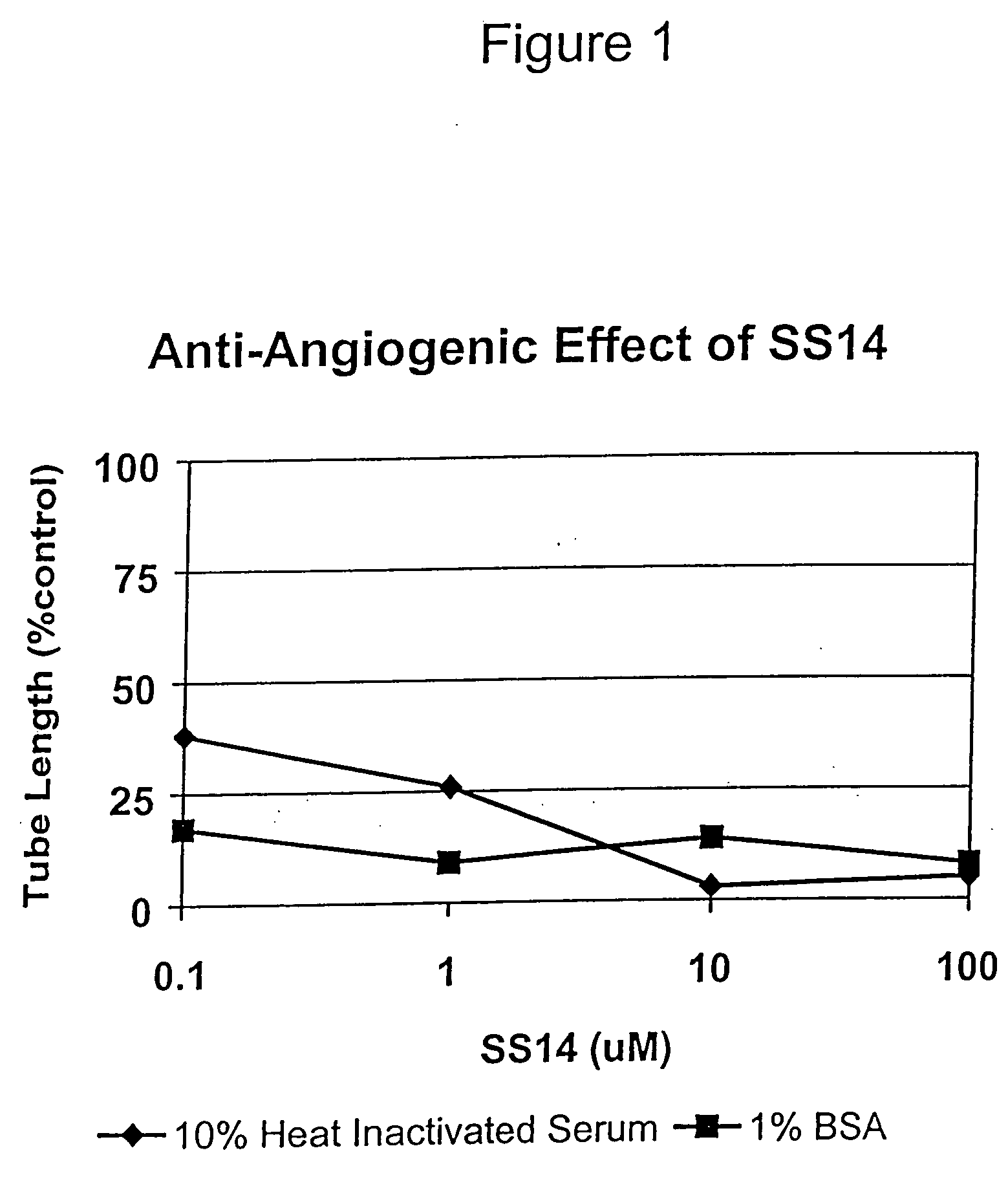Selective treatment of endothelial somatostatin receptors
a somatostatin receptor and endothelial technology, applied in the field of therapeutics, can solve the problems of inconclusive use of sstr2/sstr5 agonist angiopeptin to inhibit intimal hyperplasia causing restenosis in human patients, and extremely short half life of ss in vivo, and achieve the effect of inhibiting angiogenesis
- Summary
- Abstract
- Description
- Claims
- Application Information
AI Technical Summary
Benefits of technology
Problems solved by technology
Method used
Image
Examples
example 1
Anti-Angiogenic Effect of SS14
[0026] This example shows the anti-angiogenic effect of SS14 on endothelial cell capillary-like tube formation in vitro, using an established model of angiogenesis. The model is based on the propensity of human endothelial cells, particularly ECV304 cells, to form capillary-like tubes on Matrigel, a basement membrane extract (Hughes, 1996, Experimental Cell Research 225:171).
[0027] Five mg vials of SS14 (Biomeasure Incorporated) were reconstituted using 1.0 mL 0.01% BSA / 0.01N acetic acid / PBS to achieve a working stock of 3 mM. The human endothelial cell line ECV304 (ATCC) was cultured in Medium 199 (M199, Sigma) supplemented with 2 mM L-glutamine (Gibco BRL), 1 mM sodium pyruvate (Gibco BRL), 5×10−5 M 2-mercaptoethanol (Sigma), 100 U / mL penicillin (Gibco BRL), 100 μg / mL streptomycin (Gibco BRL), 20 mM HEPES (Sigma), and optionally 10% heat-inactivated fetal calf serum (Gibco BRL) or 1% BSA. Cells were passed at a rate of 1:5 using 0.05% trypsin / 0.005%...
example 2
Characterization of Human Endothelial Cells
[0030] The endothelial characterization of the ECV304 cells used in the present invention was confirmed by the detection of von Willebrand Factor (vWF) mRNA by RT-PCR and the detection of vWF by immunocytochemistry (vWF is a well known functional marker of endothelial cells that is involved in vivo in the blood clotting cascade). The ECV304 cells used herein also expressed the endothelial marker endothelial nitric oxide synthase (eNOS). RT-PCR provided evidence for the presence of SSTR1 and SSTR4 mRNA in ECV304 cells and in a primary endothelial HUVEC cell line from umbilical veins. Neither cell lines expressed SSTR2, SSTR3 or SSTR5 mRNA, with the exception that later passages of some HUVEC cultures showed low levels of SSTR2.
[0031] The ECV304 and HUVEC endothelial cell lines were immunostained for SSTR1 and vWF, identifying the location of the SS receptors. The EC304 and HUVEC cell lines showed SSTR1 immunostaining in both the cytoplasm ...
example 3
Effect of an SSTR1 Selective Ligand on Human Endothelial Cells
[0052] It has been demonstrated that SS acting through SSTR1 regulates intracellular pH (Barber et al., 1989, J. Biol. Chem. 264:21038) and that intracellular pH in turn regulates actin stress fiber production (Tomninaga et al., 1998, Mol. Biol. Cell. 9:2287). The present Example illustrates the common effects of SS14 and an SSTR1 selective ligand agonist on actin bundling in endothelial cells, using fluorescently labelled phalloidin to localise actin.
[0053] To assay the effect of SS14 on endothelial cells, ECV304 cells were washed to remove growth medium and fresh medium (lacking serum) added (1 ml / well). The cells were cooled to 4° C. for 15 minutes to concentrate SSTRs at the plasma membrane prior to the addition of SS14 (10 nM, Peninsula Laboratories; Belmont, Calif.) to test wells while control wells received a similar volume of medium only. The cells were subsequently incubated at 37° C. for 30 min, fixed in 4% PF...
PUM
| Property | Measurement | Unit |
|---|---|---|
| concentration | aaaaa | aaaaa |
| concentration | aaaaa | aaaaa |
| pH | aaaaa | aaaaa |
Abstract
Description
Claims
Application Information
 Login to View More
Login to View More - R&D
- Intellectual Property
- Life Sciences
- Materials
- Tech Scout
- Unparalleled Data Quality
- Higher Quality Content
- 60% Fewer Hallucinations
Browse by: Latest US Patents, China's latest patents, Technical Efficacy Thesaurus, Application Domain, Technology Topic, Popular Technical Reports.
© 2025 PatSnap. All rights reserved.Legal|Privacy policy|Modern Slavery Act Transparency Statement|Sitemap|About US| Contact US: help@patsnap.com

